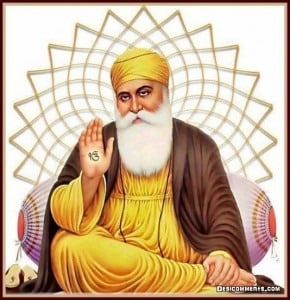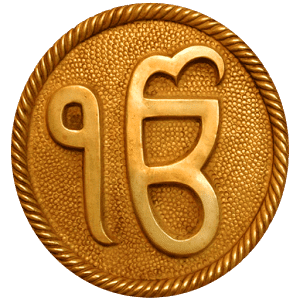Sikhism: A Tradition Striving for Unity and Truth

Sikhism is the fifth largest religion in the world(one of the fastest growing, too) and originated in Northern India in 1469. Sikhis (meaning disciple or learner) are monotheistic, believe in the unity and equality of all mankind, engage in selfless service, and strive for the prosperity of all life. There are over 25 millions Sikhis in the world.
Sikhism originated in a guru tradition in 1469; Guru Nanak was the first to establish what because a religious tradition over the course of centuries. Ten gurus followed in Guru Nanak’s footsteps and after the death of the tenth guru, Guru Gobind Singh, the Guru Granth Sahib became the literal embodiment of the eternal, impersonal guru and serves as a guide for Sikhi’s.
The Ten Sikhi Gurus (each represents a divine attribute) are:
- Guru Nanak – Humility
- Guru Angad – Obedience
- Guru Amar Das – Equality
- Guru Ram Das – Service
- Guru Arjan – Self-sacrifice
- Guru Hargobind – Justice
- Guru Har Rai – Mercy
- Guru Harkrishan – Purity
- Guru Tegh Bahadur – Tranquility
- Guru Gobind Singh – Royal Courage
A couple of the Sikhi gurus are also Bhakti saints giving Hinduism an interesting relationship with the origins of the Sikh religion. The goal of the Sikhi is unison with the divine and they believe that no one tradition has a monopoly on the divine and emphasizes the “five thieves” of god’s presence: lust, rage, greed, attachment and conceit.
The Origins of Sikhism
Sikhism was created in the Punjab region, which is between India and Pakistan. In the time of the first Guru, Guru Nanak, there were two competing religions of the Muslims and Hindus. Legend says Nanak went into a river at 28, proclaimed there is no Hindu or Muslim, only god and that he continued to bring Sikhism into the world.
The 5th Guru, Arjan was a scholar and helped to build the Sikh religion by creating the first scripture. However, he was seen as a threat by the state and executed for his faith in 1606.
The 6th Guru, Hargobind eventually moved to militarize the community and the Sikhs learned to fight to preserve their faith. They became relatively peaceful until Tegh Bahadur, the 9th guru, was executed in 1675 by Aurangzeb, the Moghal Emperor. The Moghal Empire consolidated Islam in South Asia, and spread Muslim (and particularly Persian) arts and culture as well as the faith.
The 10th Guru, Gobind Singh, created the Khalsa as a military group so that they could forever defend their faith.
The Sikhs continued to rebel against Muslim oppression and eventually became a state of their own. But then they were defeated by the British. Then they became peaceful for a while, until 1919 when there was a massacre of over 400 dead and 1,000 wounded by British soldiers who fired on a crowd of protesters. A few historians signify this event as the beginning of the decline of the British Empire in India.
The Sikhi god: Ik Onkar
Ik Onkar is the Sikhi word for god and means ‘all pervading spirit’. This spirit has no gender, is beyond time and space, is without form, beyond the comprehension of humans, but not completely unknowable. The spirit is visible  everywhere to the spiritually awakened through the heart or “inner eye”. The religion prescribes meditation to allow for communication between god and man.
everywhere to the spiritually awakened through the heart or “inner eye”. The religion prescribes meditation to allow for communication between god and man.
The Opening Line of the Mool Mantar:
“There is but one all-pervading spirit, and truth is its name! It exists in all creation; it does not fear; it does not hate; it is timeless and universal and self-existent, you will come to know it through seeking knowledge and learning!”
The ultimate goal of a Sikh is to be completely united with god. They achieve this state of liberation (mukti) by focusing on god rather than themselves.
Maya: the Worldly Illusion
Maya is a spiritual concept that has evolved over time and crosses over nearly every eastern religion in one way or another. Literally, Maya means delusion, extraordinary illusions of power, the veil of perception, magic, and “unreality”.
These worldly illusions are viewed as a direct opponent of realizing god in this lifetime (the goal of the Sikh is to realize god). It is believed that the object of Maya, or object of the senses, lust, desire, attachment, ego, greed, and anger which are known as the 5 thieves and are believed to take away from the individual’s relationship with god by distracting and hurting the individual.
Once god is fully realized, the individual is considered jivanmukta and liberated in this lifetime, which is a belief also shared in Hinduism. After this liberation, the individual is ceaselessly united with Brahman (the supreme truth underlying all of reality, but hidden by it). Sikhs also believe in reincarnation and karma.
The Khalsa – the Nation of Sikhs
The Khalsa is the collective body of all Sikhs. The Khalsa was initiated on March 30 1699 by Guru Gobind Singh, the tenth and last Sikh guru. The word Khalsa means “sovereign”, “free”, or most often “pure”. Being initiated into the Khalsa is a type of baptism and males are entitled Singhs (lion) while females are titled Kaurs (princess).
The Khalsa is responsible for all executive, military, and civil authority in the Sikh society. They are considered the pinnacle of Sikhism and perform no rituals and believe in no superstitions. They only believe in god who is the master and creator of all, the only destroyer/creator.
A Sikh is defined as any human being who faithfully believes in one immortal being; ten gurus, from Guru Nanak to Guru Gobind Singh, the teachings of the ten gurus and the baptism bequeathed by the tenth guru.
Culture, Observations, and Rituals of Sikhism
Most Sikhs wake up early to meditate on the name of god. Then he/she bathes in a pool of nectar (I’m not really sure what this means, probably some type of sweet herbs and spices). Then he chants the name of the lord. All sins, misdeeds, and negativity is erased through this process. When the sun rises, the Sikh is to meditate on the name of god again. The idea of the Sikh’s existence is to worship god so that they can maintain a close relationship to god.
There are 5 K’s(panj kakaar) or articles of faith that baptized Sikhs are obligated to wear:
- Kesh – uncut hair, usually tied and wrapped in a Dastar (a style of turban)
- Kanga – a wooden comb, usually under the dastar
- Kachera – cotton undergarments worn by both sexes to symbolize chastity
- Kara – an iron bracelet, a weapon and a symbol of eternity
- Kirpan – an iron dagger of differing sizes. In the UK it is very small and in Punjab it can be up to three feet long.
Sikhs are also very interested in music, many instruments were supposedly created by gurus. These instruments include the Rebab, the dilruba, the taus, the jori, and the sarinda. They would often play drums or Nagaras while marching into battle.
The Modern Sikh and Sikh Statistics
There are about 27 million Sikhs worldwide and 83% live in India. 76% live in Punjab where they form  2/3rds of the populace. Sikhs were some of the first to migrate to Britain from India and were used in the Indian Civil service and so were spread out over the entire British empire. Many have spread throughout Europe and Northern America.
2/3rds of the populace. Sikhs were some of the first to migrate to Britain from India and were used in the Indian Civil service and so were spread out over the entire British empire. Many have spread throughout Europe and Northern America.
The caste system is still very prevalent within the Sikh religion, even though their gurus denounced the system. Untouchables, or Dalits still face harsh discrimination.
The first gurdwara (place of worship) was established in the United States in Stockton, California.
Discrimination against Sikhs has risen since the 9/11 attacks. They are said to be often confused with Arabic or Muslim Middle Eastern men because of their turbans and CNN suggested an increase in hate Crimes against Sikh men after the attacks. I’ll leave it to a few clips from CNN and other news to show you what I mean by discrimination (it involves racism and persecution because of ignorance).
- The U.S. has the highest murder rate of affluent democracies. America had an extreme homicide rate of 5.4 per 100,000 people in 2008-2009, compared with a 1.43 rate in England and Wales and a 1.3 rate in Italy. Japan has 1/10 of the murders of the US. Don’t be surprised about how often this happens.
- [September 24th, 2013] A Columbia University professor who wrote about hate crimes against Sikhs may have become a victim of one himself when 12 to 15 people attacked him while shouting anti-Muslim slurs, police said.Prabhjot Singh, a Sikh and a professor of international and public affairs, said the attackers were yelling “get Osama” and “terrorist” when they swarmed him Saturday night near Central Park in New York.“There were about 20 of them. A few surrounded me, and started punching me,” Singh said, according to the Sikh Coalition. He suffered injuries to his face, including displaced teeth and a possible fracture in his lower jaw. CNN ARTICLE
- [August 5th, 2012] There was a shooting of 6 people in Wisconsin in a hate crime on August 5th 2012. ‘He said members described the attacker as a bald, white man, dressed in a white T-shirt and black pants and with a 9/11 tattoo on one arm — which “implies to me that there’s some level of hate crime there”.’The gunman started shooting in the parking lot, then entered into the temple and proceeded to open fire. Most of the victims were leaders of the church, men with turbans. CNN ARTICLE
- [September 13th, 2015] A Sikh American man says he was taunted as a “terrorist” and “bin Laden” by another driver this week, and then beaten unconscious in his car. Police in the Chicago suburb of Darien are investigating the alleged incident as a hate crime and a road rage incident that escalated into a violent attack, Chief Ernest Brown said. CNN ARTICLE
- [January 6th, 2016] A $10,000 reward is being offered in the slaying of a 68-year-old Sikh man brutally murdered in a central Fresno convenience store on New Year’s Day. They have video of a light-skinned suspect between 16 and 18 with a red hoodie that waited outside for about 5 minutes for a man named Gill to be in the store alone. Once Gill (Sikh man without any Sikh attire on) was within about a foot, the suspect stabbed Gill repeatedly. Gill tried to push himself away, retreated and picked up a golf club. The suspect knocked Gill to the ground before returning to the cash register, which he could not open. He then took something from a shelf and walked out of the store in the same direction from which he approached. Gill died of his wounds minutes later. Sikhs were anxious about heading back out into the community because of another attack that occurred on December 26th. FRENSO BEE ARTICLE
- [March 2nd, 2016] Balwinder Jit Singh says a passenger beat him while calling him a terrorist and a suicide bomber last year in Inglewood. YAHOO NEWS ARTICLE
So this is very real, and its happening right now. This article from THE INTERCEPT talks about how Donald Trumps campaign makes it extremely hard on Sikh’s because hatred and violence are condoned. These are Americans that are discriminated against in our own country. And in lots of cases the police turn a blind eye, refuse to investigate, or whatever nonsense racism and ignorance they can make up. But this seems to happen a lot and we, as a nation, should not allow this kind of intolerance or ignorance. This is the 5th largest religion in the world!

